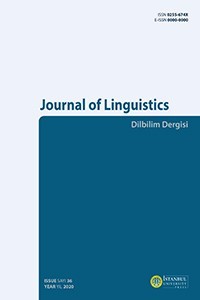Gelişmeyi Bekleyen Hazine: Dünyadan Örneklerle “Dilsel Parmak İzi” İncelemecisi Adli Dilbilim
Adli dilbilim, suçun yazılı ve sözlü deliller yolu ile incelenmesini sağlayan, söz konusu incelemeyi bir takım dilbilimsel analiz ve ölçüm yöntemi ile gerçekleştiren bir adli bilimler dalıdır. Adli dilbilim, ülkemiz sınırlarında henüz gelişmeyi bekleyen bir suç araştırma alanıdır ve alana dair atılacak her türlü adım, ülkemiz vatandaş haklarının korunması ve adaletin sağlanması için elzemdir. Doküman inceleme yöntemi kullanılarak yapılan bu çalışma, adli dilbilimin tanımını yaparak adli dilbilimcilerin gerçekleştirdiği analiz yöntemlerinin suç ve suç incelemesi kapsamında önemini ve değerini vurgulamak için kaleme alınmıştır. Çalışmada, adli dilbilimsel yöntemler kullanılarak aydınlatılan gerçek vaka örnekleri verilerek alanın önem ve gerekliliği gözler önüne serilmek istenmiştir.
Anahtar Kelimeler:
Adli Dilbilim, Dilbilimsel Analiz, Suç, Hukuk
The Treasure-Awaiting Development with Cases from the World: Forensic Linguistics as “Linguistic Fingerprint” Examiner
Forensic linguistics, a sub-branch of forensic science, investigates crime through written and oral evidence by following certain linguistic analysis and measurement methods. Forensic linguistics is a crime-solving field that is yet to be improved within the boundaries of our country; moreover, each step concerning this field is essential to protect the rights of our citizens and ensure justice in our country. This study, which was conducted using the document review method, has been penned to emphasize the importance and value of analysis methods of forensic linguists in crime and crime-solving by introducing forensic linguistics. In this study, real cases enlightened through forensic linguistics methods are mentioned and exemplified to reveal the importance and necessity of the field.
Keywords:
Forensic Linguistics, Linguistic Analysis, Crime, Law,
___
- Atasoy, S. (2013). Kusursuz Cinayet Yoktur, Kusursuza Yakın Olanlar Vardır. Doğan Egmont Yayıncılık ve Yapımcılık Tic. A.Ş., 5. Baskı, 224-225.
- Bilge, B. (2014). AİHM İçtihatları Bağlamında Etkin Soruşturma Yükümlülüğü, İnönü Üniversitesi Hukuk Fakültesi Dergisi, Cilt: 5, Sayı: 2, 368-369.
- Doğan Alakoç, Y. (2010). Adli Bilimlerde DNA Analizleri, Ankara Üniversitesi Dikimevi Sağlık Hizmetleri Meslek Yüksekokulu Dergisi, Cilt: 9, Sayı: 2, 2.
- Grant, T. (2013). TXT 4N6: Method, consistency, and distinctiveness in the analysis of SMS text messages. 21 J. L. & Pol'y, https://brooklynworks.brooklaw.edu/jlp/vol21/iss2/9, 467-494.
- Larner, S. (2014). Forensic Authorship Analysis and The World Wide Web. Palgrave Macmillian, 2-4.
- Lininger, T. (2005). The Promise and Shortcomings of Forensic Linguistics, Creating Language Crimes: How Law Enforcement Uses (and Misuses) Language. Cornell Law Review, 92 (No: 4), 833-864.
- Olsson, J. (2008). Forensic Linguistics: Second Edition. Continuum International Publishing Group, 4.
- Sapir, E. (1927). Speech as a Personality Trait. American Journal of Sociology, Vol: 32, No: 6.
- Sudjana, E.T.S., Fitri, N. (2013). Kurt Cobain’s Suicide Note Case: Forensic Linguistic Profiling Analysis. International Journal of Criminology and Sociological Theory, Vol: 6, No: 4, 217-227.
- Svartvik, J. (1968). The Evans Statements: A Case For Forensic Linguistics. Gothenburg Studies in English.
- ISSN: 0255-674X
- Yayın Aralığı: Yılda 2 Sayı
- Başlangıç: 1976
- Yayıncı: İstanbul Üniversitesi
Sayıdaki Diğer Makaleler
Türkçede İşlek Bir Metaforik Neoloji Öbeği: X+Kafası
Bilge Merve KARADAĞ, Seda BURNAZ
Yabancı Dil Olarak Türkçe Öğretiminde B1 Düzeyinde Dinleme Sınavı Geliştirme
Berna TARI YARDIMCI, Murat ELMALI
Gelişmeyi Bekleyen Hazine: Dünyadan Örneklerle “Dilsel Parmak İzi” İncelemecisi Adli Dilbilim
Yabancı Dil Olarak Türkçe Öğretiminde Yabancıların Eşdizimsel Örüntüleri Algılamaları
Twitter’da Covid 19 Söylemlerinin Derlem Dilbilim Yöntemi ile İncelenmesi
